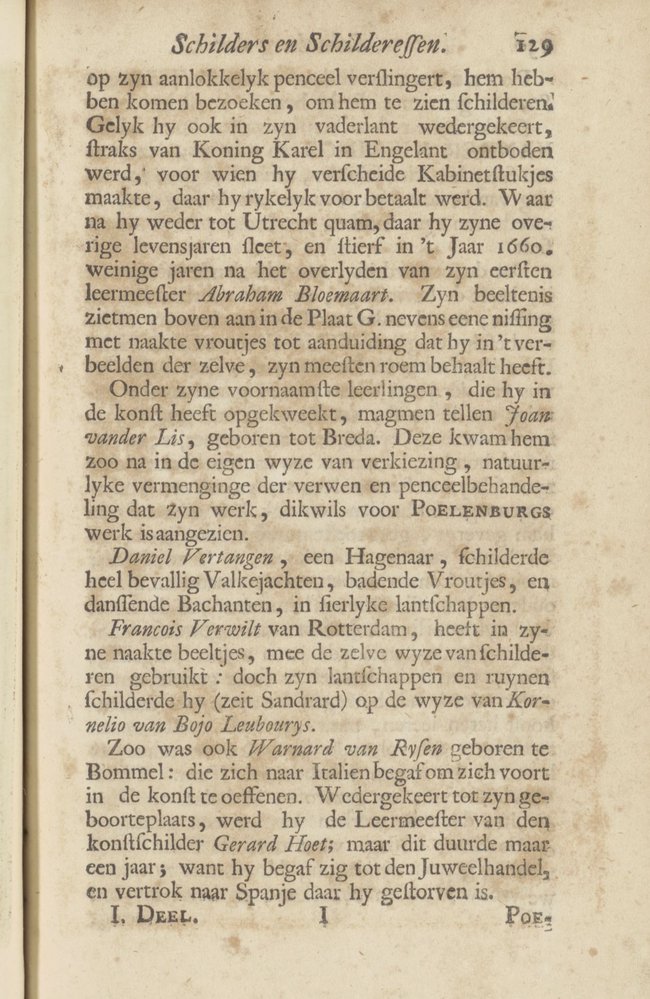Volume 1, page 120-129
Page 120
mentions one Jan Adriaensz, who was a good landscape painter.
In these early days Friesland also had a hidden fire of art flare up amongst its city dwellers.
PIETER DE VALCK, born in Leeuwarden in 1584, was the son of a silversmith and a citizen of the capital of Friesland. I do not know with whom he learned art, but I know that in his youth he practiced after the brush art of Abraham Bloemaert (says Johannes Hilarides of Bolsward) is clear from a piece of painting that is still to be seen with his daughter’s daughter, Antje Ieppes of Sneek, to whom we will return further on.
Valk later travelled to Italy to continue to practice his art, where he remained several years on end. Having returned home he married and gained two sons who in their youth also travelled yonder, the one driven by his love of art, the other of his craft and as company for his brother on the long journey. But they, misled and cheated by a Genovese man, were sold into slavery on the Barbary Coast, never again to turn up. In the meantime the father painted various portraits, histories, and landscapes etc., now in Leeuwarden at the Prinsenhof, which continue to be valued and are still to be seen.
His half-length portrait, skilfully and precisely painted by himself in 1605, in his 21st year, which may be seen in Sneek with his daughter's daughter, also demonstrates that he must have been an excellent master.
Antje Ieppes, mentioned above, made a drawing after this work and sent it to us from Sneek
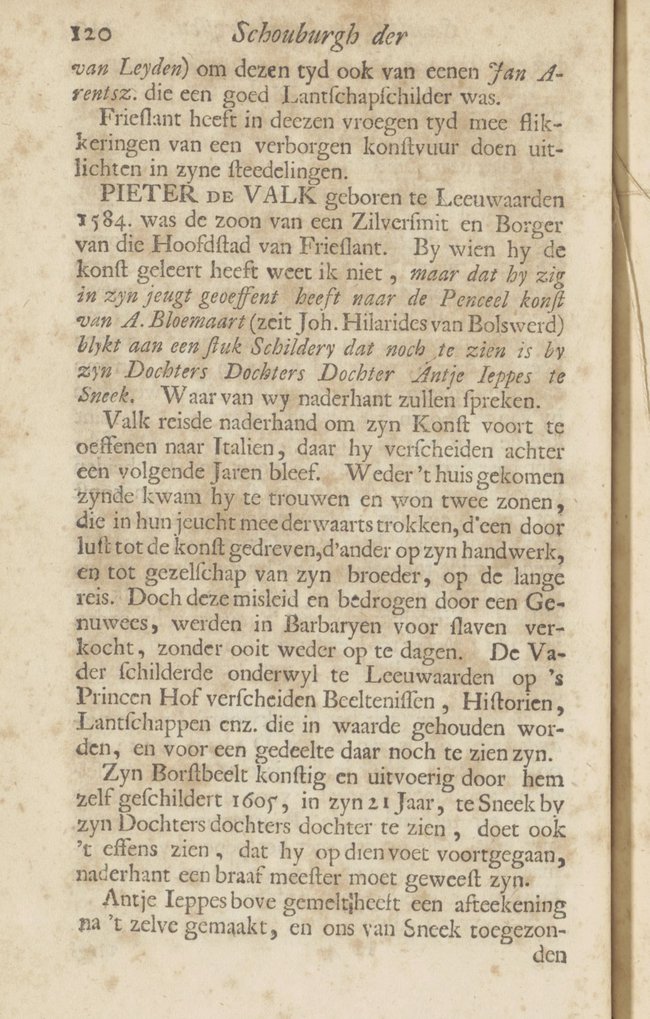
Page 121
to keep the memory of her great-grandfather alive amongst painters. One sees this image in Plate G.
WILLEM VAN DER VLIET (who descended as a younger son) of the old noble family Van der Woert, was born in Delft in the year 1584, had a deft and flowing brush, painted histories (says the city chronicler) but later turned to the painting of portraits until he died in December of 1642, 58 years old. He also had a brother’s son named Hendrick van Vliet, who was also an artist and for many years practiced the painting of histories, night lights and perspectives under the supervision of his uncle. He later moved on to the renowned Michiel van Mierevelt, to practice painting portraits. But his small churches seen from within and in the manner of Emanuel de Witte, with inventive cast light and small figures, please me most.
GUILLIAM VAN NIEULANDT, born in Antwerp in the year 1584, was a student of Roelant Saverij in Amsterdam, with whom he arrived in the year 1594 to study art, after which wanderlust, especially native to painters, entered his head. He left for Rome and lived there for three years with the renowned Paul Bril. His inclination extended especially to the depiction of ruined Roman buildings decayed by time, triumphal arches, temples, bath houses, graves and such hiding places of owls and bats, or to decayed hollow caves, where one hears the echo resonate, of which he also etched a good many himself with the needle in copper. He was also
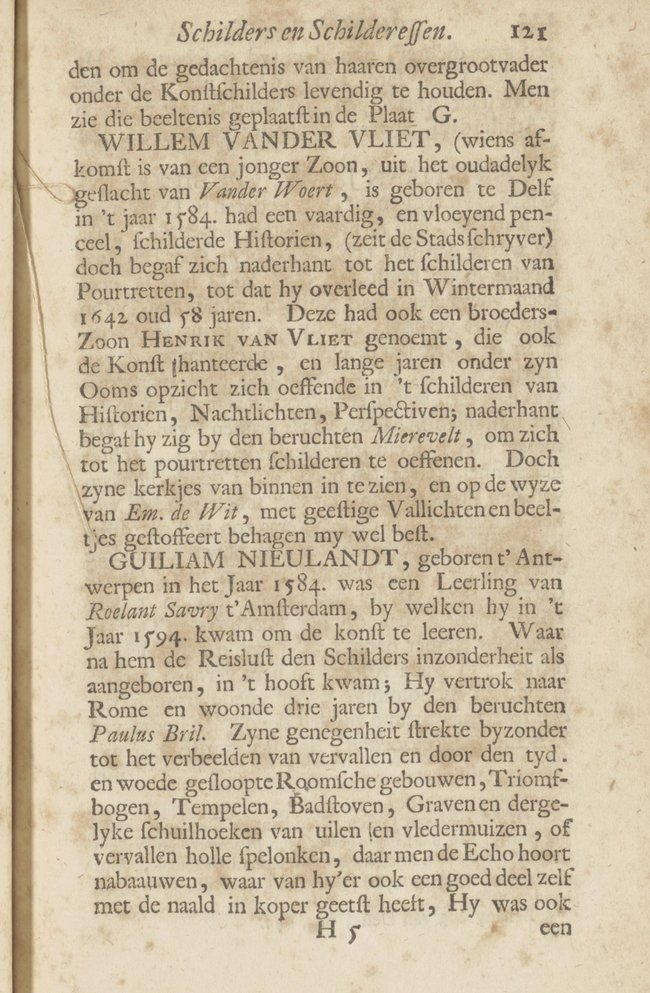
Page 122
a good poet, as estimated according to his time. In the year 1607 he returned to Antwerp, his native city, and from there with his household to Amsterdam, where he died in the year 1635.
CHRISTIAEN JANSZ. VAN BIESELINGEN, his contemporary, was born in Delft, but in what year I have not been able to discover. By the year 1584 he was already famous as a good master in art and as such I have not been able to assign him a better place. It is told about him that in that same year that the Prince of Orange* was shot to death by Balthasar Gérard in Delft (after which the States forbad the painting of any portrait after his features because it might fall into the hands of the prince’s enemies, giving them means to mock him) he found opportunity to see the dead body of the prince and was able to make a sketch of the face, with the likeness so well captured that people later judged it superior to all --other drawings. That is why in the year 1620 Hendrick Pot§ used it as his model for the great piece that hangs in the room of the aldermen in the city hall of Delft. What is further told about him is this, that he went to visit some of his good friends, who were about to undertake a journey to Spain, on board of the ship, to drink the last farewells
--------
* David Flud van Giffen, preacher in Dordrecht, has a portrait of Balthasar Gerards, the murderer of Willem I, Prince of Orange, among his rarities. It was drawn after life by Christiaen Jansz. van Bieselingen while Gerards was bound.
§ Beschryvinge der stad Delft, page 845.
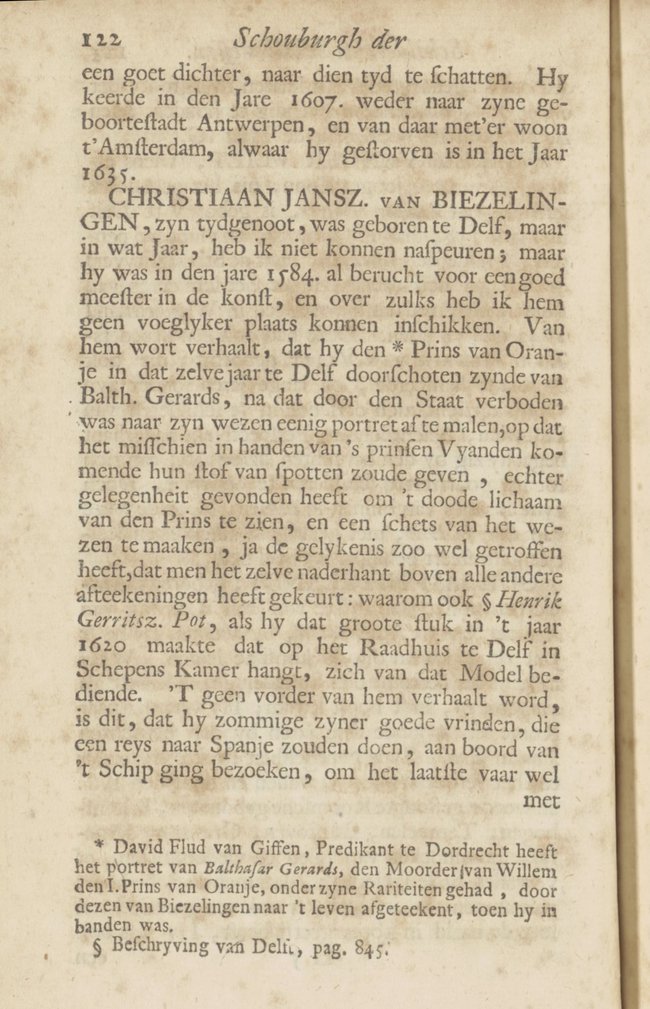
Page 123
with them. And with that jollity and the strong insistence of his friends (while the sailors were already hoisting the sails) he went on the journey with his wife and two children. Arrived in Spain, he ended up at the court in Madrid and remained there until his wife had died, after which he shipped for Holland, where he married another, with whom he went to live in Middelburg in Zeeland, where he also died when 42 years old.
The city of Antwerp, which (in comparison to other Netherlandish cities) can probably provide the greatest roll of names, also has the honour that in the year 1585 there was born within her walls
GASPER DE CRAYER, about whose fame Cornelis de Bie speaks thus:
Because all he does is sweetly steeped,
Most gracefully sweet and lush, diffused and cradled.
He studied art with Raphael Coxie and progressed so much with the passage of time that he is ranked with the most famous artists. To his art still witness Brussels, Ghent etc., as well as Nazaret, located near Lier, where he painted several altarpieces which can arouse the mind to attentive contemplation.
Herewith appears the painter and moral poet DIRK RAFAELSZ. CAMPHUYSEN, born in Gorkum in the year 1586.
His father Rafaël Camphuyzen, who sprang from a noble family, was a physician, beloved by all for his medicine and pleasant behaviour.
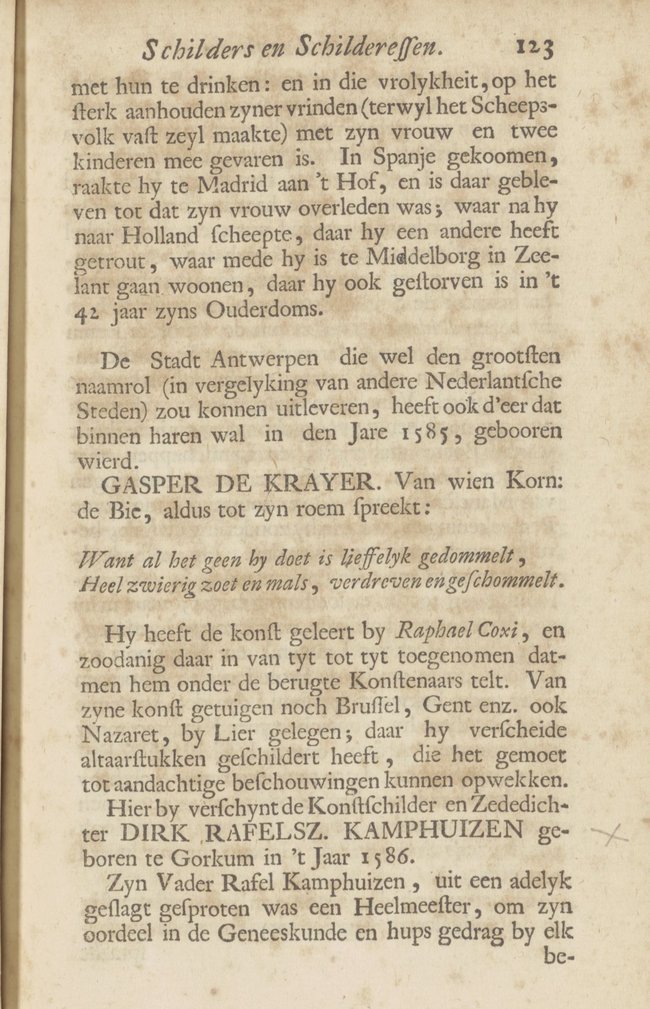
Page 124
His mother [=Maria van Maseyck] (whose father Hans van Mazeik, a merchant of Gorkum, was beheaded for professing his faith) was famous for her exceptionally pious life amongst the Mennonites. She died when Dirk was eight years old, and his father followed her shortly thereafter. His oldest brother, who was married and who took care of his father’s shop after his death, seeing that his youngest brother had a great intellect and was inclined to the art of painting, placed him with one Dirck Govertz. to study art, whom he was not only able to approach in art after diligent practice but also to outstrip him. I got to see some of his painted scenes in which were depicted farmer’s stables and landscapes with figures, cows, horses etc. and also depictions of moonlight scenes. Some of his pen drawings, at which he especially excelled, also remain amongst his friends. He practiced art until his eighteenth year, when, recommended to do so, he moved on to the practice of languages, in which he progressed so much above average and behaved so well that when Mister Van Langerak and Nieuwpoort came to Leiden to learn from the professors if they did not know a competent person at the academy to whom he might entrust his children in that respect, Arminius especially recommended our Camphuijsen. He subsequently entered that service and acquitted himself so well that he was later appointed as Van Langerak’s secretary or confidential clerk.
In the meantime he had diligently practiced theology in his spare time and being well-spoken
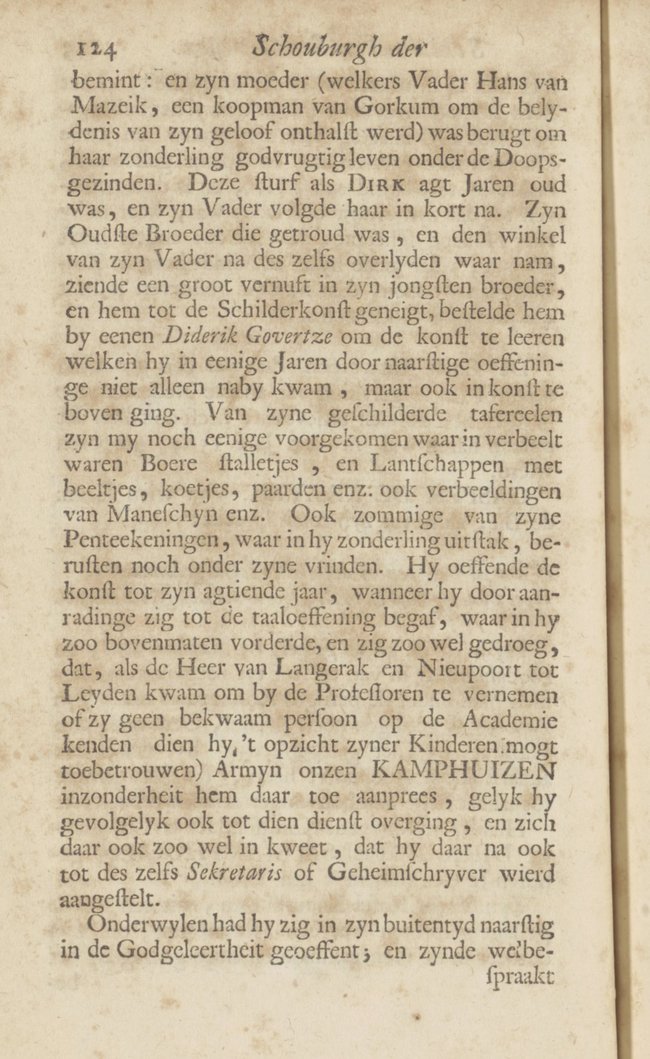
Page 125
and of a commendable life, his friends recommended that he quit that service and apply himself only to the pulpit, which succeeded. For when after some travels, he had taken over the preaching engagement of the Reverend Jacobus Taurinus in the cathedral of Utrecht to great pleasure of the community, he got a permanent position in Vleuten due to recommendations from Ledenberg and Langerak.
Always to sail with wind and tides is rarely the fate of the pious. What happens? When, one morning, he is sitting in his study, a frighteningly large owl swoops in with much noise, and sets itself down before the glass window. It again resumes its flight, enters his room with great force through the panes and settles on the writing desk, looking at him horribly wide-eyed. He, however, more than a little upset by this, grabs this animal and tosses it against the wall so that it dies. He finally picks it up and carries it downstairs to show this monster to his wife (for he was already married by then), who was no more pleased with this incident than he, fearing that it augured nothing good but was an omen (says the writer) that the church-owls would torment him, as happened. After some days an interdiction was pronounced in which Camphuijsen and all those sharing his convictions were forbidden not only the pulpit but also teaching in houses and barns, as well as in the open field, at pains of seizure of body and goods. Since that time he has had to roam about in distress here in the land and elsewhere and to hide with one or another of his friends. Which is why
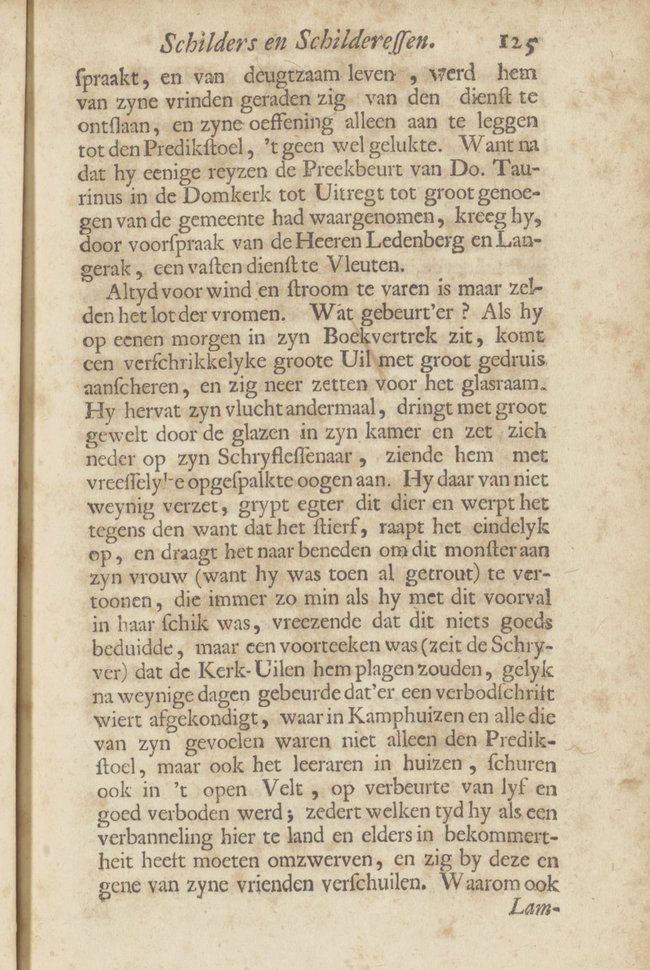
Page 126
Lambert Jakobsz, painter and preacher in Leeuwarden, advised him to cease preaching for a while and take up some other civilian profession, such as running a shop. But his ardour was too heated to listen to that counsel, not shirking to suffer the danger that followed him with reluctant shoes. And how terribly the doctrine of Arminius and whatever was shaped on that last was hounded at that time, appears from this one example, that his mother, who lived in Dordrecht, housed him for one night with hesitation, fearing trouble, seeing that at that time it was as dangerous to house a Remonstrant under one's roof as a monster. Tantum potest praejudicata opinio. Prejudice can accomplish that much, says Cicero. Enough thus far.
He left a son who practiced the art of painting, but there is little to be said in praise of him. And it struck us as strange that a father who tried to scare everyone off art, did not inculcate an aversion to art in him. Yes one had even accused the good man of idiocy until Het leven van Dirk Rafelsz. Kamphuizen by Pieter Rabus, printed in 1699 by Jan Rieuwertsz, fell into our hands and established that he was only the translator and not the writer of the satirical poem Idolelenchus, which is part of his works of poetry and begins thus:
Image-laden hand of the painter, mimicker of God's hand,
By this poem I wish to paint you for the intellect;
Temptress of sight, which relies on what's mortal.
Your magic poison is also the ruin of the soul.
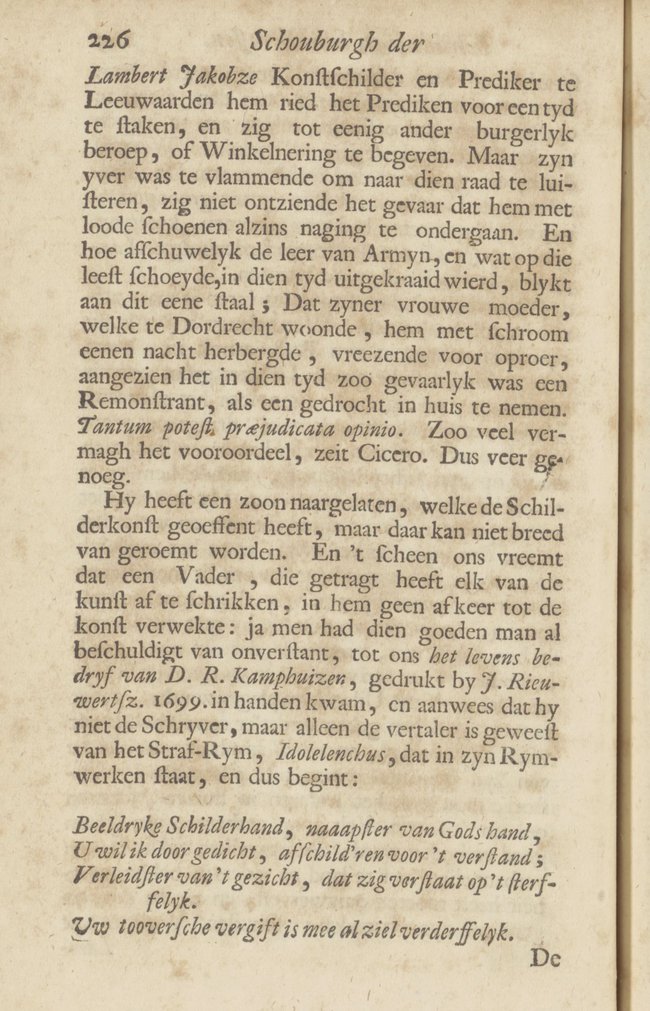
Page 127
The construction of this entire satire is built on the abuse of art. When Emperor Julianus commanded that his statue should be placed among the statues of Jupiter, Mars and Mercury and many other gods and commanded with serious threats that it should be accorded divine worship, who was to blame for or was the cause of this reprehensible idolatry? Not the artist for being its maker and placing the emperor’s portrait amidst the statues of the gods, while the former could have had no greater respect for the work than for any other statue. Just as is told about a certain woodcarver who had made a small statue of Christ from palm wood which, being ill, the priest held up before him. And as he paid not the least homage to or respect for the crucifix, the priest, being most surprised, asked him if he no longer recognized his God, as he had shown no proof of it, to which he answered: Should I not know what I have made myself from palm wood? But it was the emperor (to return to our previous subject) who by scandalous ambition forced his subjects to bow before the statue. In this way sculptures, once made, are only elevated through abuse, and in this way Arnoldus Geesteranus could also have despised the wine, which has its uses, because it is often abused. He who has made the following rhyme,
Does he who makes images with paints, from wood or stone.
Also make the gods? No, but he who falls down to worship them.
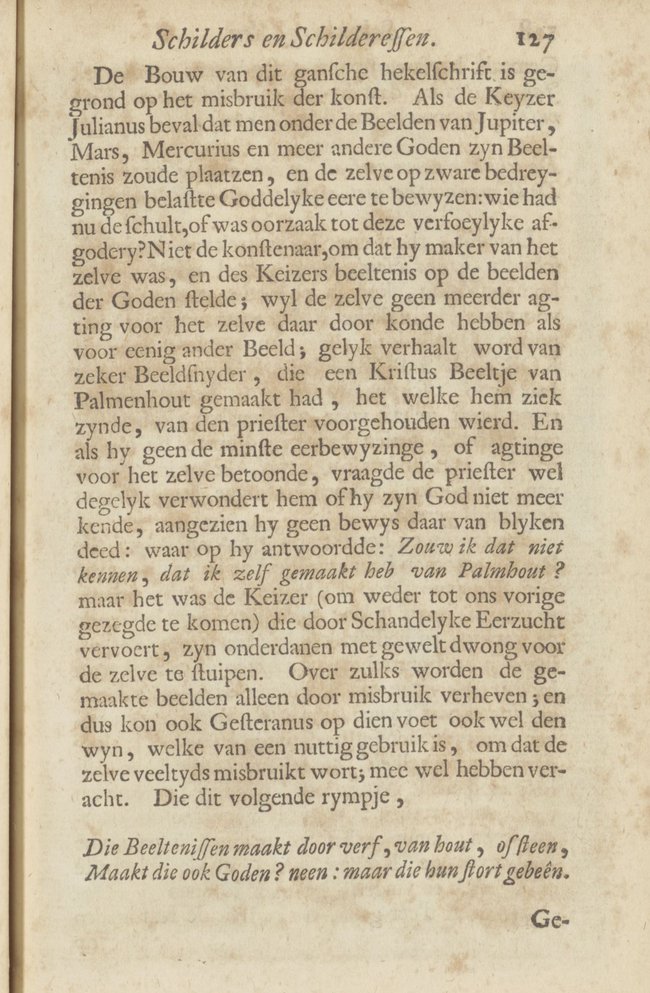
Page 128
understood this much better, and thus also Johan de Brune II when he says (in his Wetsteen der vernuften) with respect to the wine:
Blame yourself when you do something while inebriated,
It is not the wine that does it, but the one who drank it.
Utrecht, now almost entirely stripped of art practitioners by the departure of the painter Gerard Hoet I, could in times gone by pride itself on many intellects, like many important Dutch cities Not the least among these was CORNELIS VAN POELENBURCH, born in the year 1586. It seems to me that century had no esteem for artists unless they had seen Rome. After all, most of the painters of that time who appear in my writings already travelled there in their youth.
Poelenburch also followed that track. Arrived in Rome, the handling of Adam Elsheimer pleased him, so that he intended to follow his example. But it was not long before he was charmed by the soft and sweet treatment of Raphael, especially with respect to his nudes. He finally adopted his own way of painting and henceforth practiced after life and came so far that he excelled over his contemporaries in tenderness, plumpness and beautiful outlines, as well as in pleasant preferences, witty inclusion of old ruins, naturally coloured landscapes, and thin and clear skies, to which his multitude of artworks to be found in respected cabinets, can witness.
He had the honour that various cardinals,
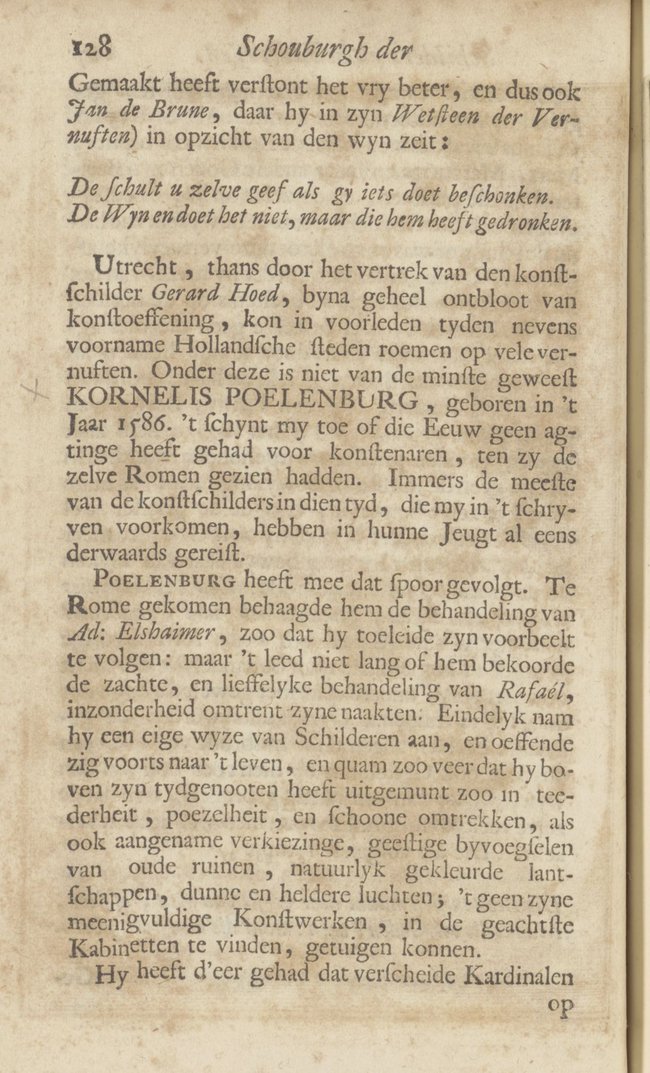
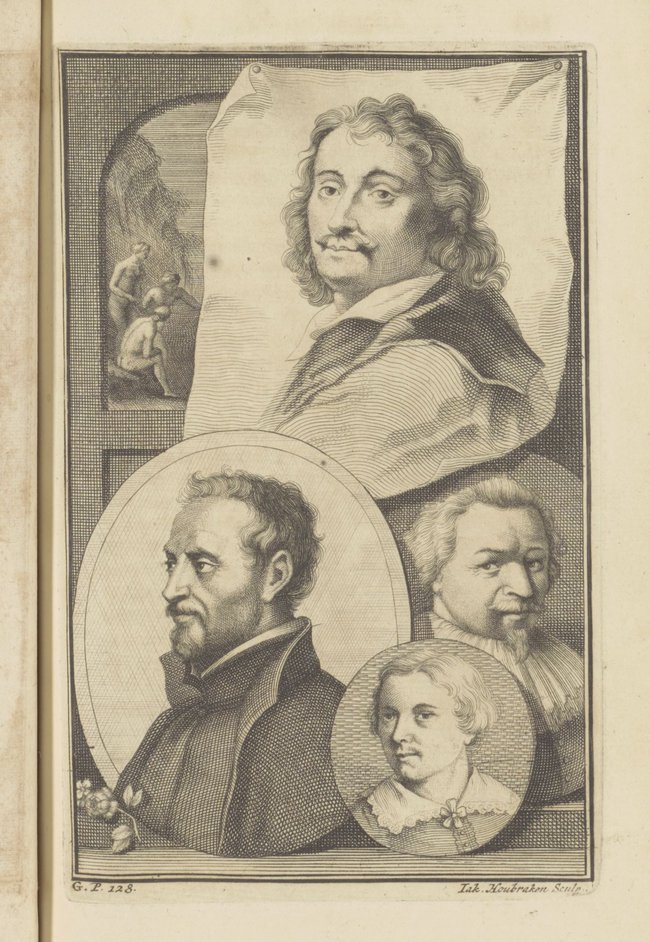
Page 129
addicted to his attractive brush, came to visit him to watch him paint. Just as when he had returned to his fatherland he was at once summoned by King Charles of England, for whom he made various cabinet pieces, for which he was amply paid. After that he again went to Utrecht, where he passed the remaining years of his life and died in the year 1660, a few years after the passing of his first teacher Abraham Bloemaert. One sees his portrait at the top of Plate G, next to a niche with nude women, as indication that he had acquired his greatest fame with their depiction.
Among the most important students that he raised in art one may count Jan van der Lijs born in Breda. He approached him so closely in his preferences and natural blending of paints and brushwork that his work is often taken for Poelenburch’s.
Daniel Vertangen of The Hague painted pleasing falcon hunts, bathing women and dancing bacchantes in graceful landscapes.
François Verwilt of Rotterdam also used the same way of painting for his nude figures, but (says Sandrart) he painted his landscapes and ruins in the manner of Cornelis van Poelenburch.
There was also Warnard van Rijsen, born in Bommel, who went to Italy to continue to practice his art. Returned to his place of birth he became the teacher of Gerard Hoet. But this lasted only one year, for he took up the trade in jewels and left for Spain, where he died.
